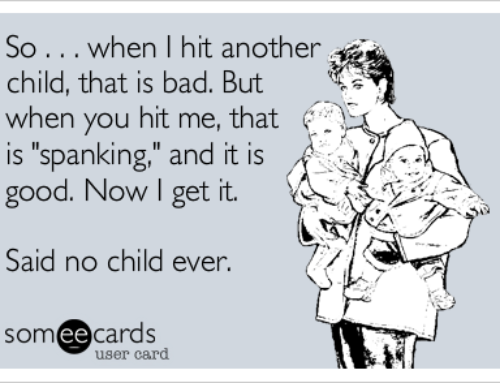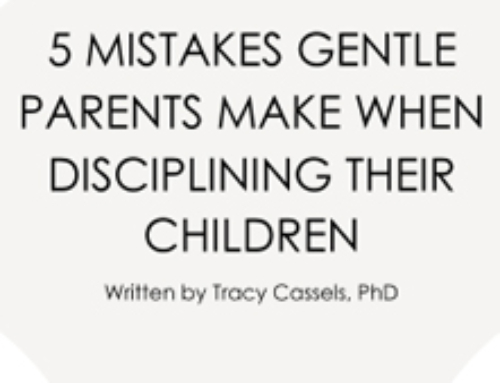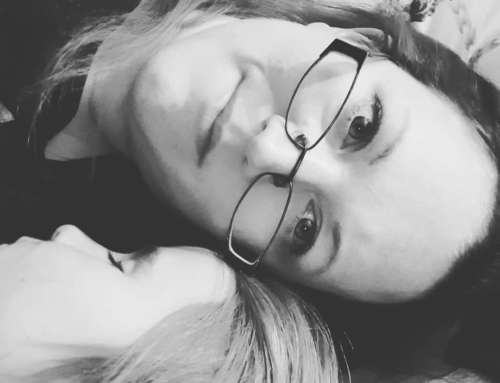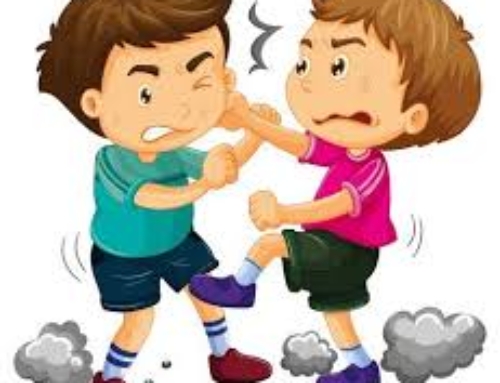When I wrote about the benefits of adding logical consequences to our toolkit with our daughter, I was met with some resistance from people. Most of the resistance centered on the fact that people view logical consequences as punishment and children don’t learn from punishment. I disagree and I thought I’d share a bit more on how to implement a logical consequence, along with what it does and does not include.
It’s Logical
Though this sounds obvious, you’d be amazed how many people think consequences are logical, when in fact they are not. Key to this point is that it has to follow from the action and be logical to the child. This means you have to put yourself in the mindset of a much younger person. We are able to see connections between a lot of things – including holding ideas over time – but younger children are incapable of that. This means that the consequence should (a) follow immediately and (b) be tied to the act at hand. In the example given in the benefits of logical consequences, if my daughter throws toys at anyone, we take the toy away until she’s ready to have it back (i.e., calmed down, discussed, and requested). This logically follows because she sees what hurt someone taken away – even she can understand that. If I were to take away dessert or bedtime story or bathtime or all toys, it wouldn’t follow and wouldn’t make sense to her as to why act A led to consequence X instead of consequence A.
Notably, when it is your child that is hitting (and they are old enough; we’ll discuss younger children hitting below), it is perfectly logical to remove them from the situation. In essence, they are like the toy. This does NOT mean a time-out, which is a forced time, but a removal from the situation either with you to calm down, or if they do not want to be with you (or you’re angry enough it’s better that you’re away too) than removed, but not forced to stay away, they should be able to choose when to return (choice will be discussed below).
It Teaches
This is where much of the contention comes from. In the example of throwing toys, people rightfully point out that children don’t have the self-regulation to always stop that (unless made to fear outcomes which none of us want). But that assumes the only lessons a child learns from behaviour and outcomes are to do with their own physiological growth. But here’s what gets ignored – I am also concerned with her learning perspective-taking, cultural expectations, and how to consider outcomes not just for the moment but for everyone (the whole do unto others as you would have done unto you idea, in a crude way to put it). It is my job to help her develop all of these aspects and sometimes that does mean imposition of something I have decided (just like society as she gets older).
In the case of the toys, she has to learn how her actions affect me and taking away the toy until she’s calm enough to play with it shows her how much that hurt me. Not that you don’t talk to the child too (this will come up shortly), but sometimes actions do speak louder than words; to realize that she has hurt someone so much that the toy has to go away highlights the severity of her actions, especially when we don’t take this act lightly. When the toy goes away, my daughter realizes she has truly hurt someone, something my actions and words were not conveying well enough before (and trust me, we worked it).
And because we spoke of what she would want to happen if someone did it to her, she’s learning that her behaviour doesn’t exist in a vacuum – that we as a society, a family, any group, set up rules we agree upon to help us function. Are some of them arbitrary? Yes, but they are set up by us all (and yes, a child should be involved in the discussion of consequences and have a say in what is chosen). As children get older, they should have even more say in the process and this early limited involvement should help assist children in understanding this process and to help them be honest about what is fair for a given action. And children do know when a consequence is too severe and too lenient for a given act. They grow up being aware of what kind of consequence they would want to see if someone hurt them, and by using that as a discussion platform, we as parents can help our children take the perspective of those who hurt them and come up with a fair idea of what to do (including making amends, which should not be forced, but come from the child).
So you have to make sure learning is going on. If you look at your consequence and find there’s absolutely nothing being taught, it’s not a logical consequence, but a punishment.
It’s Age-Appropriate
For any consequence to be logical and to teach, it has to be age-appropriate. This means that for younger children, often just helping them self-regulate is all that’s needed. For example, an 18-month old starts hitting, you should have a time-in period where you move away from the stimulus and cuddle and help your young one calm down. Remember that young children still rely heavily upon you for their physiological regulation. As children age, they become more capable of understanding the effects of their behaviours and other consequences (outside of just being removed) can be helpful in teaching the various aspects of socialization we are hopefully trying to teach. This is why we didn’t start removing toys from our daughter until she turned 3 and was showing the capacity to see that connection better. This didn’t mean we didn’t have to remove dangerous items from her before – quite the contrary – but we knew there was no learning going on and it was purely for safety.
Included in this is that certain behaviours do not deserve a consequence. If a child is behaving in an age-appropriate way and there is no risk of harm to him/herself or others, why do we need to impose a consequence? You don’t. And respecting the developing child and his/her capabilities means realizing when a logical consequence is needed and when it is not appropriate (no matter how logical it is).
It Includes Discussion and Connection
If a consequence is not followed-up with time with your child to talk about what happened, why it happened, and to make sure they know they are loved and cared for regardless of any behaviour, it’s not going to work. Well, it may work in terms of changing behaviour, but you may have unintended consequences. This is why so many people instead focus solely on the discussion and emotional connection – it’s key to socialization. (I just disagree that it’s all there is to socialization.) Importantly, the timing of this is key. In the moment (and sometimes for a while after), the child remains in the state of “fight or flight” and they are unable to actually take in any information and no learning will occur through discussion. All parties must be calm. If your child has been removed, they have to have chosen to come back and if you are holding your child and helping to regulate them, you will need to see that your child has calmed down before proceeding.
What to discuss? First, you need to listen to your child and connect emotionally. Find out how your child feels. Your child may be upset by both whatever prompted the action (though sometimes it’s just done for play) and the consequence and it’s absolutely 100% okay to comfort them and let them know that you are there and love them. People often mistake love and care for permissiveness and they are worlds apart. If the consequence is in place, making sure your child knows s/he is loved regardless of the behaviour is key to helping them learn. Not offering that simply serves to shame them. Then you need to talk to your child about the reasons behind the behaviour – what drove it? This is critical if you hope to help your child learn alternate options and to plan moving forward (see the last point). Third, you need to make sure your child understands the logic of the consequence and explain why B follows A. Finally, you need to make whatever points you are trying to make about perspective-taking. This will probably include how the person who was hurt felt, or the possible natural consequences to the action that may be worse, and how the child would feel if it happened to them. This can be the springboard to talking about making amends and getting the child involved in discussion of the fairness of the consequence and what the child would want if roles were reversed.
It Includes Choice
Choice is key to the concept of making children responsible for their actions. Consequences happen, but when children are given the choice to try again, you tell them that you trust their judgment and give them the opportunity to explore their own emotions and learn to judge for themselves what they are capable of at a given moment. Now, sometimes younger children – when placing themselves in danger – will not get a second chance right away, it may be the next visit. A discussion BEFORE the visit is then in order to remind the child about safety and whether the child wants to try and be safe or to have an alternate plan.
In the case of older children, often after a discussion and some calm-down time, they may be ready to try again and we should allow them. Especially if we have spoken to them about the dangers. And of course, if they, for example, throw a toy at someone right away, it may be fair to say they need to wait a day because you simply can’t keep watching over them to keep them and others safe. But you must explain why the choice is no longer there for that day.
Notably, when choice is involved, it means that the child is aware of the consequence prior to the chance of them behaving in a way that would lead to the consequence. Coming up with a consequence, no matter how logical, when the child has no warning that this is even a possibility means the child has no choice in the matter and this is a problem. Clearly if it’s dangerous you act however you see fit to keep your child safe and have a discussion after, but if we’re not in the dangerous territory, the first act should lead to a discussion and a decision as a family on how to move forward. And then the child knows, though younger children (and some older) will need regular reminders of the consequences of certain actions.
It Leads to Planning by You
One of the most important things when you have logical consequences is to take all the information you gleaned from talking to your child, seeing their responses and reactions, gauging your own reactions and to plan accordingly for the future. If you notice that your child is getting upset close to bedtime, perhaps move bedtime up a bit. If your child tells you that they hit you because they want your attention, make it a priority to give them your attention more than you are. If they tell you brushing their teeth hurts, try a softer toothbrush. Learn the cause and see what can be done – by you or your child – to help prevent situations that may result in you having to use logical consequences.
Sometimes I think we forget about this aspect once we have a logical consequence, instead falling back on the consequence as the only thing we use to help teach. And that can’t be. Logical consequences are a part of our toolkit, not the entire thing. Relying on only one method to help teach and guide our children rarely works because children are so different and the reasons why they end up in certain situations vary so greatly and how we respond to different situations will vary greatly. All this is to say that we need to be sure that we really focus on making sure we use these experiences to learn as well – it’s not just for our children.






I probably will fail to convince you that your methods are not that different from the ones who use time outs. Attempting to control the behavior without looking at the underlying needs is the old way. There are newer ways that involve figuring out what the unmet needs are that lead to the unwanted behavior, but you probably know about them and don’t believe in them. I think though, that I will at least attempt to post a couple of alternate views. I know Love and Logic and similar approaches are popular, and that they are considered more gentle, but when it comes right down to it, you are still manipulating your child. The “logic” of them does not withstand the question of: would you really do the same thing to another adult? You take the toy away because you can — you have power. You are using your larger size and strength to take the toy away from someone smaller. Instead of figuring out why she is throwing the toy. Also, the “choice” is also a false manipulative one: if you continue this (undesirable from my point of view) behavior, I will make the following undesirable (from your point of view) thing happen. That’s a threat. Would you really do that to another adult? I don’t even see that condition in your list anymore by the way. You are assuming that your child will only learn socially acceptable behavior if you over power her and force her to change. Is that fear-based? I understand that kids often behave in undesirable ways (mine do too), but they mostly only do so because they are not developmentally ready to behave any differently. Sure you can scare them into compliance, but that’s not true learning.
For those of you who wish to read up more on this topic, read the following:
http://www.activistpost.com/2010/10/journey-to-unschooling.html
http://joyfullyrejoycing.com/influencing%20kid%20behavior/naturalconsequences.html
http://www.naturalchild.org/jan_hunt/22_alternatives.html
http://joyfullyrejoycing.com/unschooling/howunschoolingworks.html
http://learninghappens.wordpress.com/2010/04/25/two-things-about%C2%A0unschooling/
http://www.unschoolingblog.com/?p=250#content
Jennifer, I’m curious how you read that you don’t look at the underlying needs. That’s part of the entire thing about discussion and emotional connection! It HAS to be a part of it or else it’s true, you’re simply giving consequences with no learning and moving forward for anyone.
The question of would I do this to another adult? Absolutely – we do it all the time. You’re driving drunk? Your license is taken away. Someone comes to my house with a bat to hit me, I will take the bat away if I can (or harm them if I can’t to get them away). This is EXACTLY what we do with adults. And like I would with an adult, I try to figure out WHY – if you read the post, you would see that. And choice is still there so I don’t know what you mean that it’s not there (?!). Is my daughter afraid? Nope. She just knows that if she isn’t safe with her toys, they go away until she decides she’s ready to be safe. I’m crediting her with knowing this and I expect her to “mess” up. But she will still learn to consider the effects on others in the interim instead of focusing solely on her.
You’re focusing on the most extreme situation — law breaking. Does throwing your toys equate with driving drunk? Are you actually in danger? If a coworker was angry and threw something at you, would you take it away from them? How does this scale when you think about it?
I think you are saying that since the reward/punishment system of the law exists and that adults are rewarded or punished based on it, that rewards and punishments are in fact valid ways to treat children. How often do you break some small law, and figure that you won’t get caught? Say, speeding, or crossing against the red light or not at a crosswalk? Should you be punished? Looking at the larger society, while it may be true that drunk driving is illegal, it doesn’t stop a large number of people from doing it does it? My sister in law regularly drives while intoxicated, yet she has never once gone to jail or even been ticketed for it and she is in her 50s. If the threat of going to jail really worked, then the jails would be empty. If going to jail actually taught people not to commit crimes, we would have no repeat offenders, would we? But in fact we do. Why? Is it because the people who commit crimes are stupid, ill, or evil? We have the highest incarceration rate in the western world, yet we still have plenty of murders and other crime. Does it work?
Just because there are laws and jails in our society doesn’t mean that we have to treat our children the same way. Did you even read the links I posted or are you just responding to what I wrote, because I’m a pretty lousy writer and pretty bad at constructing a coherent argument (12 years of public school and 5 years at a top four year public university didn’t teach me much about it). I do know that the majority of child development is based on behaviorism, which is essentially “training” children in the same way that circus animals are training. You didn’t sleep train your child, yet you are advocating the same approach to parenting older children that came up with the sleep training method.
For a child? Yes, we have rules to keep us safe and when my daughter throws a wooden, hard toy at someone, she can truly hurt them. And yes, if a coworker threw something at me, I would not hand it back! I understand you focus on equality – but my view is different. Children learn with boundaries and respect, and you can respect a child and include them in decisions about consequences, but still be the one “in charge”. Sleep training is about denying a child’s biological needs – logical consequences in older children (as I mentioned, if they are too young to take part in the conversation about perspective-taking and what consequences they would want, they are too young for logical consequences) is one tool to help them consider their actions and other people.
Reward/punishment is very different from logical consequences. I know some (like Kohn) think logical consequences are lite punishment, but I disagree. I do however see how some use it as such (why I wrote this guide). Did you read through the entire guide I wrote? A logical consequence is punishment if there’s no choice, if there’s no emotional connection, no discussion of why, no planning by the parent after to help the child grow and learn and prevent behaviour, and definitely if things are taken for a set period (like in our society). And yes, I’ve read most of what you posted (though don’t have the time to read all, but am well-versed with Kohn in particular).
Oh, and Alfie Kohn calls logical consequences “punishment lite” — that’s an entertaining way of putting it.
http://www.alfiekohn.org/teaching/pbracwak.htm
One more statement about it and I’m off to nurse my three year old:
If you have to impose it, it’s top-down, not equal!
http://positiveguidanceparenting.com/?p=777
Why do you expect all relationships to be equal? Our children are not equal – they don’t have the developmental capacity to be equal. Why they require more consideration in many ways! And more teaching.
Please post more on this. I am there with my 3 year old. I want her to learn what it means to live in community, but it’s a daily grind! Thanks so much for all your work and posts. It’s a great conversation starter!!
Hm,, now that I’ve seen more of your blog post about this, I think maybe my way of trying to get you to look at it is not going to work. Let’s just take the example of the coworker – if you physically took something from them, how do you think they would react? Do you think you would teach them anything? Do you think that your relationship with them would improve? Do you think that perhaps there might be more of a fight?
I actually posed it not in the hopes that you would think of your child as a coworker or adult, but to get you to think of what kind of power dynamic it takes to impose a consequence or punishment on your child. It means power over.
http://www.drmomma.org/2013/11/when-things-get-physical-hitting.html
If an adult threw something at you at work, they would likely lose their job. Life has logical consiquences.
Sometimes the thing that is being taught is simply the very fact that actions have consequences. We may think of this as obvious, but cause-and-effect is something young children actually have to learn. That’s why toddlers love building up stacks of blocks just to knock them down – they’re learning that something happens when they push the stack over.
And heck, yeah, I want to teach my children that hurtful behavior has negative consequences, even when it’s “no big deal.” Because I’m not willing to wait to let them drive drunk and kill someone before they experience this. It’s far better for everyone – the child included – to learn to discipline themselves before their “toys” are motor vehicles and power tools.
We now have an entire generation raised by parents who didn’t grasp this basic concept – that children have to learn that their behavior has consequences – and, frankly, it’s made for a mess of a society full of entitled so-called “adults” who can’t play well with others.
Like it or not, small children are not little adults, and imposing a logical consequence will not look the same to a child as to an adult. Would we physically remove a weapon from an adult who’d used it? Yeah – and we do. A hard toy in the hands of a child who’s throwing it is the same thing. The difference is not that the coworker is an adult; the difference is that you are not the authority in your coworker’s life; you’re a peer. You are the authority in your child’s life. If I threw a wooden building block at a police officer, you can bet your you-know-what that he’d take it away from me – and arrest me, to boot!